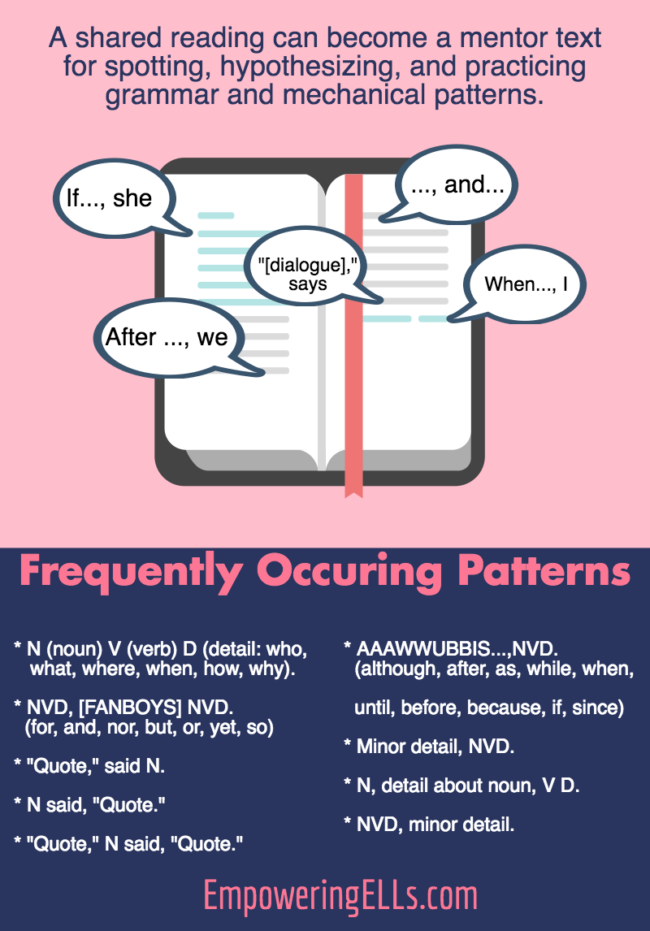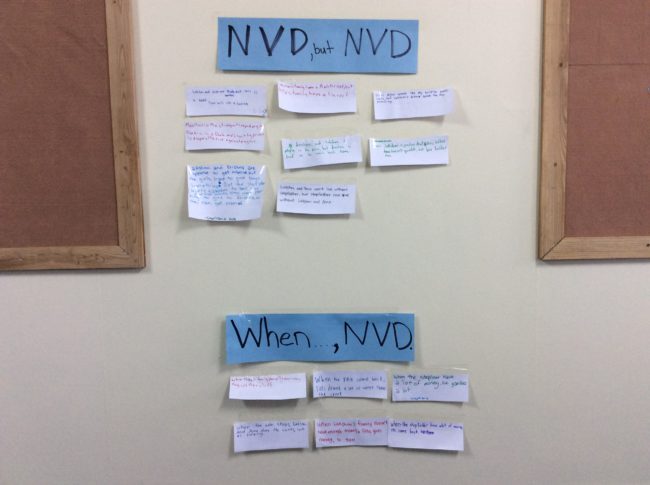Goal
The goal of this article is to share a process of teaching grammar instruction to ELs within context. I hope that this process makes language patterns visible for your learners and provides a way for you to teach grammar in context.
Research Says
Braddock, Lloyd-Jones, and Lowell Schoer (NCTE) (as cited by Lyons, 1996) argued that time should not be given to grammar instruction. They wrote, “[t]he teaching of formal grammar has a negligible or, because it usually displaces some instruction and practice in actual composition, even a harmful effect on the improvement of writing” (n.p.). This is seen in the movement away from stand-alone grammar instruction to in-context learning.
I developed a bad taste in my mouth about grammar instruction from my own teachers’ pedagogical choices. I remember them insisting that we have a specific “grammar-learning time” from elementary school onwards. This was a 15-minute time period when we opened up our grammar books, listened to our teacher explain a grammar rule, and completed the accompanying workbook pages for reinforcement.
Because I remember this painfully boring and ineffective approach to grammar instruction, I decided to not teach grammar at all my first two years in the field. Instead, I prioritized developing reading comprehension and the writing process. Not surprisingly, my students’ grammar skills did not improve during this period. I figured out my first grammar mistake was that I did not directly teach it.
What I didn’t realize was that Braddock, Lloyd-Jones, and Lowell Schoer were not suggesting ignoring grammar instruction. They were advocating for an in-context approach. Weaver (1996) proposed that educators actually should teach grammar, but by framing grammar instruction as a tool for supporting writing (as cited by Lyons, 1996). For Weaver, teaching in context means seeing grammar as just a tool for writing. For me, grammar instruction is also an important scaffold for comprehending texts.
Past Practices
Mistake: Death by Daily Oral Language
Trying to help my teaching dilemma, one of my Teach For America colleagues suggested that I use daily oral language (DOL) to help teach grammar. DOL is a practice designed to train students to spot and correct grammatical and mechanical mistakes. Regrettably, this approach did not help teach grammar for two reasons:
- as a non-contextualized approach to grammar instruction, it treated grammar as an isolated workbook exercise
- it tried to teach writing without actually having students write.
Jeff Anderson said that, “ No other subject is taught through wrongness. Why does teaching grammar have to? “. For a comprehensive list of the defects of DOLs, please read Mark Pennington’s blog, “Why Daily Oral Language (D.O.L) Doesn’t Work”. Make sure to read some of the reader responses in the comment because this is a rather polarizing topic.
I shamefully admit that during my fourth year of teaching, I too fell for the DOL trap and taught grammar using this approach. During that year, however, my students’ grammar usage did at least marginally improve.
But that all came to an end when another Teach For America colleague suggested that I read Jeff Anderson’s (2005) enlightening book entitled Mechanically Inclined: Building Grammar, Usage, and Style into Writer’s Workshop. In the next section, I’ll describe the steps I used to teach grammar that follow Anderson’s contextualized grammar workshop model.
Current Practices
Step 1: Identify a Grammar Pattern During Guided Reading
The shared texts we’re reading in class can serve as mentor texts that are full of opportunities to teach grammar and mechanics. All students have to do is just read carefully and make observations about how grammar is used to communicate ideas. Below is a graphic of this philosophy:
I begin this process by conducting a Visible Reading (my version of guided reading) of a shared classroom text. As we read, I take note of a language pattern that students will need in the future. For example, a sentence that starts with “When” is a common English construction. After we work collaboratively to comprehend the section we’re reading, I bring students’ attention back to the sentence that contains the “When”. Then, I read it aloud, making sure to pause at the comma.
After this, I write another sentence that starts with “When” on the board. Now ELs have two examples with which to make a comparison and to find the language pattern.
Step 2: Students Make Observations
In this step, we have students look at the mentor sentence and take notice of what works and what they are wondering. I invite students to study the sentence, and, to offer more scaffolding, I direct them to pay careful attention to the comma. ELs can share in table groups or in pairs to get more ideas.
With ample language pattern examples, the ELs usually arrive at an understanding of the grammar rule in about 5-10 minutes. The lesson is so short because it’s meant to provide just an initial exposure to the grammar pattern, not an exhaustive study. If all of the ELs do not get it at this moment, the language pattern will inevitably appear again in another section of text.
Additionally, when we ask students to notice, it is an inquiry approach to learning. This step differs from DOL because we are drawing students’ attention to what’s working, not correcting mistakes. When we teach students to notice language patterns, we are teaching them to be a highly effective language learner. With this language pattern noticing skill, every time students read, they are getting a grammar and writing lesson.
Step 3: Quick Write (QW) the Pattern
To internalize the language pattern, I ask students to QW a sentence in their English notebooks that mirrors the pattern we studied. This process showcases a key principle of a writing workshop: a mini-lesson followed by time for students to practice a specific skill.
Below is an image of a QW from a 7th grader practicing the “When” pattern followed by an image of QW from a 6th grader internalizing the “If” pattern.

Step 4: Reflect on the Language Pattern
I hope that students adopt the new language pattern and attempt it in their own writing, but that’s not my only goal. I also hope my students develop effective reading strategies from the grammar instruction. Language learners who understand grammar also comprehend text better, so it’s important to teach them to use their newfound knowledge of grammar patterns to help understand complicated sentence structure.
In this step, I encourage my students to do just that; to think about grammar patterns as reading strategies. The main question to ask is “What should you do when you see [language pattern] while reading?” My ideal conversation might sound like this:
Mr. Tan: Now that you have produced a sentence that starts with “When”, next time when you see a similar sentence in another text, what do you think to yourself?
Dunja: “When” means time, so when I see “When” at the beginning, I have to think ‘Oh, the author is giving us a time first. The next part of the sentence will be an event.
Reflecting like this helps ELs internalize the language pattern. To further support them, I turn the language pattern into visual scaffolds that contains the language pattern into a “formula”. Below the visual scaffold, I have students practice writing their own sentence that follows the language pattern. I make students write a sentence that is connected to the shared text we’re reading.
In this image, both of these language patterns have sentences that are about the shared text. These text-based sentences help me understand students’ understanding of the text and their internalization of the language pattern.
Grammar Instruction in Context
This workshop approach to grammar instruction is what we call “teaching in context” because it uses authentic writing from books, articles, and stories as mentor texts. The language learners acquire the language structure through discussion, and then internalize it without the aid of a workbook.
This process reframes grammar instruction into an opportunity to learn how language is used to communicate ideas and how to comprehend text by being mindful of language structures and patterns. There are no “Ok, time to learn grammar now, kids” and no workbook drills. This approach is an inquiry into how language works in the texts students read. It is positive, bite-size chunks of achievement. The inquiry continues with students practicing what they discovered. Often, learning rests on students’ ability to pause and observe.
Takeaways
- Grammar aids both writing and reading.
- Grammar is best taught within context.
- This context can come from the texts students are already reading.
Next Post
Thank you for taking the time to read this post. I hope that it has reinforced your own grammar instructional strategies. We continue on the theme of teaching in context in the next few articles about vocabulary instruction. I’ll share my various techniques to teach vocabulary within context and surprisingly, one strategy that may seem “out of context”.
Feel free to download this infographic for your use or to share with colleagues.
Anderson, J. (2005). Mechanically inclined: Building grammar, usage, and style into writer’s workshop. Portland, ME.: Stenhouse.
Braddock, R., Lloyd-Jones, R., & Schoer, L. (1963). Research in written composition. Champaign, IL: NCE.
Lyons, B. (1996). Books. The Quarterly, 18(3), 15-17. Retrieved from http://www.nwp.org/cs/public/download/nwp_file/845/Teaching_Grammer.pdf?x-r=pcfile_d
Pennington, M. (2009, April 29). Why Daily Oral Language (D.O.L.) Doesn’t Work. Retrieved from http://blog.penningtonpublishing.com/grammar_mechanics/why-daily-oral-language-d-o-l-doesnt-work/
Weaver, C. (1996). Teaching Grammar in Context. Portsmouth, NH: Heinemann.




